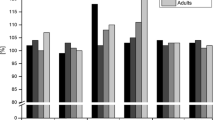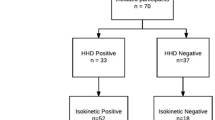Abstract
A new criterion-based evaluation test method, has been developed in order to assess the functional ability of athletes with knee injuries, ‘Tests for Athletes with Knee-injuries’ (TAK). The physiotherapist and the patient assess independently and simultaneously the patient’s performance. The TAK comprises eight demanding functional activities with emphasis on strength, stability, springiness and endurance. Objectives: To evaluate the inter-rater and intra-rater reliability of TAK between the physiotherapist’s and the patient’s assessments. Further, to evaluate the relation between the functional tests in TAK and the isokinetic quadriceps muscle strength. Materials and methods: Fifty-nine subjects were included in the study. Thirty-one were anterior cruciate ligament (ACL) reconstructed, fourteen were ACL-injured not reconstructed and fourteen were healthy athletes. The inter-rater-reliability was evaluated by assessments of 59 subjects carried out by two independent physiotherapists using visual observation. The assessment was rated on a 0–10-point scale according to five elaborate criteria drawn up for each test. Simultaneously, the subjects were asked to rate their own performance on each test using a 0–10-point scale. The intra-rater-reliability of TAK was evaluated by a test–retest of 31 patients. The relation between the physiotherapist’s and the patients’ ratings as well as of the patients’ ratings at two different occasions were evaluated. Isokinetic quadriceps muscle strength was measured in a Biodex dynamometer on all 59 subjects in order to study the relation between quadriceps muscle strength and the results of the functional tests in TAK. Results: Inter-rater-reliability showed good consistency between the assessments of the two physiotherapists in seven of eight tests (κ = 0.62–0.78). The intra-rater-reliability was moderate to good (κ = 0.43–0.65) in the test–retest study. The consistency of the physiotherapist and the patients’ assessments differed, but showed good correlation. The consistency of the test–retest study of the patients’ assessment was low. The correlation between the isokinetic quadriceps muscle strength measured in a Biodex dynamometer and the results of the functional tests was moderate in this study. Conclusions: This criterion-based test method for athletes with knee injuries showed good inter-rater reliability and acceptable intra-rater reliability for the physiotherapists’ assessment. The consistency of the patients’ ratings was low. The correlation between isokinetic quadriceps muscle strength and functional tests in TAK was moderate. The validity has not been evaluated in this study but will be done in the future.



Similar content being viewed by others
References
Altman D (1991) Practical statistics for medical research. Chapman& Hall, London
Augustsson J (2003) Kinetic chain weight training, strength assessment and functional performance testing. Dissertation, The Salgrenska Academy at Göteborg University, Sweden
Barber S, Noyes F, Mangine R, McCloskey, Hartman W (1990) Quantitative assessment of functional limitations in normal and anterior cruciate ligament-deficient knees. Clin Orthop 255:204–214
Barber-Westin S, Noyes F, McCloskey J (1990) Rigorous statistical reliability, validity, and responsiveness testing of the Cincinnati knee rating system in 350 subjects with uninjured, injured or anterior cruciate ligament-reconstructed knees. Am J Sports Med 27:402–416
Bengtsson J, Möllborg J, Werner S (1996) A study for testing the sensitivity and reliability of the Lysholm knee scoring scale. Knee Surg Sports Traumatol Arthrosc 4:27–31
Biodex Application Manual (1986) Shirley, New York, USA
Bland J, Altman D (1986) Statistical methods for assessing agreement between two methods of clinical measurement. Lancet 8:307–310
Bollen S, Orth F, Seedholm B (1991) A comparison of the Lysholm and Cincinnati knee scoring questionnaires. Am J Sports Med 19:189–190
Brosky J, Nitz A, Malone T, Cabron D, Rayens M (1999) Intrarater reliability of selected clinical outcome measures following anterior cruciate ligament reconstruction. J Orthop Sports Phys Ther 29:39–48
Daniel D, Malcom L, Stone M, Perth H, Morgan J, Riehl B (1982) Quantification of knee stability and function. Contemp Orthop 5:83–91
Eastlack M, Axe M, Snyder-Mackler L (1999) Laxity, instability and functional outcome after ACL injury: copers versus noncopers. Med Sci Sports Exerc 31:210–215
Feinstein A, Cicchetti D (1991) High agreement but low kappa. I. The problems of two paradoxes. J Clin Epidemiol 43:543–549
Gauffin H, Pettersson G, Tegner Y, Tropp H (1990) Function testing in-patient with old rupture of the anterior cruciate ligament. Int J Sports Med 11:73–77
Greenberger H, Paterno M (1995) Relationship of knee extensor strength and hopping test performance in assessment of lower extremity function. J Orthop Sports Phys Ther 22:202–206
Harter R, Osternig L, Singer K, James S, Larson R, Jones D (1998) Long-term evaluation of knee stability and function following surgical reconstruction for anterior cruciate ligament insufficiency. Am J Sports Med 16:434–443
Hefti F, Muller W, Jacobs R, Stäubli H (1993) Evaluation of knee ligament injuries with the IKDC form. Knee Surg Sports Traumatol Arthrosc 1:226–234
Holm I (1996) Quantification of muscle strength by isokinetic performance. Dissertation, National Hospital, Oslo, Norway
Hubley C, Wells R (1983) A work-energy approach to determine individual joint contributions to vertical jump performance. Eur J Appl Physiol 50:247–254
Irrgang J, Anderson A, Boland A, Harner C, Kurosaka M, Neyret P et al (2001) Development and validation of the international knee documentation committee subjective knee form. Am J Sports Med 29:600–613
Irrgang J, Ho H, Harner C, Fu F (1998) Use of the international knee documentation committee guidelines to assess outcome following anterior cruciate ligament reconstruction Knee Surg Sports. Traumatol Arthrosc 6:107–114
Keays S, Bullock-Saxton J, Keays A (2000) Strength and function before and after anterior cruciate ligament reconstruction. Clin Orthop Rel Res 373:174–183
Krebs D, Edelstein J, Fishman S (1985) Reliability of observational kinematic gait analysis. Phys Ther 65:1027–1033
Lephart S, Perrin D, Fu F, Gieck J, McCue F, Irrgang J (1992) Relationship between selected physical characteristics and functional capacity in the anterior cruciate ligament-insufficient athlete. J Orthop Sports Phys Ther 16:174–181
Lysholm J, Gillquist J (1982) Evaluation of knee ligament surgery results with special emphasis on use of a scoring scale. Am J Sports Med 10:150–154
Murray MP (1967) Gait as a total pattern of movement. Am J Phys Med 46:290–333
Neeb T, Aufdemkampe G, Wagener J, Mastenbroek L (1997) Assessing anterior cruciate ligament the association and differential value of questionnaires, clinical tests, and functional tests. J Orthop Sports Phys Ther 26:324–331
Noyes F, Matthews D, Mooar P et al (1983) The symptomatic anterior cruciate-deficient knee Part II: The result of rehabilitation, activity modification, and counseling on functional disability. J Bone Joint Surg 65:163–174
Ounpuu S (1992) The biomechanics of running: A kinematic and kinetic analysis. In: Greene WB (ed) Instructional course lectures 38, III. American Academy of Orthopeadic Surgeons, Park Ridge, pp 305–318
Risberg M, Ekeland A (1994) Assessment or functional tests after anterior cruciate ligament surgery. J Orthop Sports Phys Ther 19:202–217
Tegner Y, Lysholm J, Lysholm M, Gillquist J (1986) A performance test to monitor rehabilitation and evaluate anterior cruciate ligament injuries. Am J Sports Med 14:156–159
WHO (2003) International Classification of Functioning, Disability and Health (ICF). Geneva, Swizerland
Wilk K, Romaniello W, Sosica S, Arrigo C, Andrews J (1994) The relationship between subjective knee scores, isokinetic testing, and functional testing in the ACL-reconstructed knee. J Orthop Sports Phys Ther 20:60–73
Öberg U, Öberg B, Öberg T (1994) Validity and reliability of a new assessment of lower-extremity dysfunction. Phys Ther 74:861–871
Author information
Authors and Affiliations
Corresponding author
Rights and permissions
About this article
Cite this article
Björklund, K., Sköld, C., Andersson, L. et al. Reliability of a criterion-based test of athletes with knee injuries; where the physiotherapist and the patient independently and simultaneously assess the patient’s performance. Knee Surg Sports Traumatol Arthrosc 14, 165–175 (2006). https://doi.org/10.1007/s00167-005-0658-1
Received:
Accepted:
Published:
Issue Date:
DOI: https://doi.org/10.1007/s00167-005-0658-1




